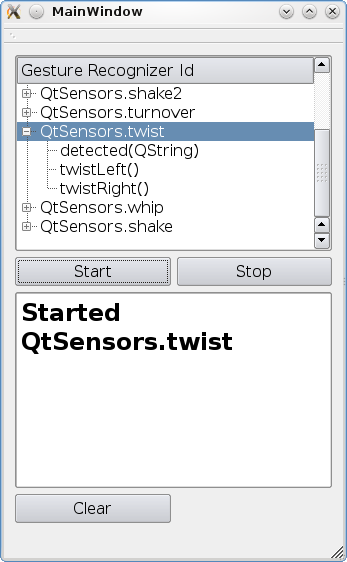
The sensor gesture example demonstrates the steps for creating a C++ application that uses sensor gestures and the included shake sensor.

QSensorGestures class defines one predefined signal, void detected(const QString &)
As well, Sensor Gesture Recognizers may implement any number of their own custom signals.
Our shake recognizer defines one custom signal, void shake(), as well as the predefined detected signal.
In order to know about custom signals that may be available, we need to ask the QSensorGestureManager about them,
Using the QSensorGesture::gestureIds() function, the manager will return a QStringList of known and valid gesture Ids.
QSensorGestureManager manager; Q_FOREACH (const QString &gesture, manager.gestureIds()) { QTreeWidgetItem *gestureId = new QTreeWidgetItem(ui->treeWidget); QStringList recognizerSignals = manager.recognizerSignals(gesture); gestureId->setText(0,gesture); for (int i = 0; i < recognizerSignals.count(); i++) { QTreeWidgetItem *oneSignal = new QTreeWidgetItem(gestureId); oneSignal->setText(0,recognizerSignals.at(i)); } ui->treeWidget->insertTopLevelItem(0,gestureId); }
We can then use this to create a QSensorGesture object that we can use to connect signals to, and start the detection process. A QSensorGesture object will take a list of one or more recognizer ids in it's constructor.
QSensorGestureManager manager; QSensorGesture *thisGesture = new QSensorGesture(QStringList() << currentRecognizer, this); if (currentRecognizer.contains("QtSensors.shake")) { connect(thisGesture,SIGNAL(shake()), this,SLOT(onShake())); } connect(thisGesture,SIGNAL(detected(QString)), this,SLOT(detectedShake(QString))); thisGesture->startDetection();
and later stop the detection process.
recognizerMap[currentRecognizer]->stopDetection(); if (currentRecognizer == "QtSensors.shake") { disconnect(recognizerMap[currentRecognizer],SIGNAL(shake()), this,SLOT(onShake())); } disconnect(recognizerMap[currentRecognizer],SIGNAL(detected(QString)), this,SLOT(detectedShake(QString)));
The QSensorGesture object will contain all the signals of the valid requested recognizers found on the system.
You can discover which of the requested recognizer ID's that were not found by using QSensorGesture::invalidIds();
By using QSensorGesture::gestureSignals(), you can get a QStringList of usable signals.
Files:

As part of the free Business evaluation, we offer a free welcome call for companies, to talk about your requirements, and how the Felgo SDK & Services can help you. Just sign up and schedule your call.
Sign up now to start your free Business evaluation:

